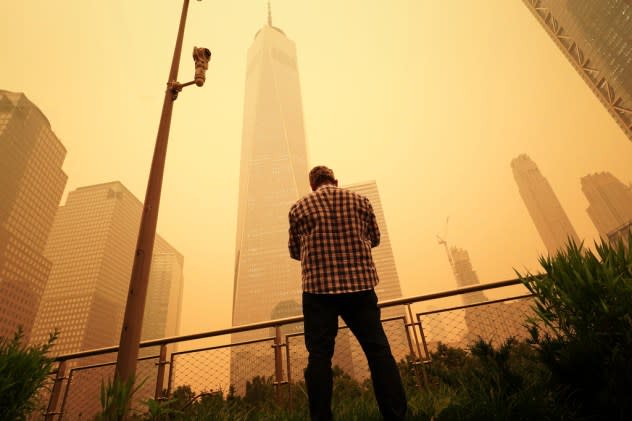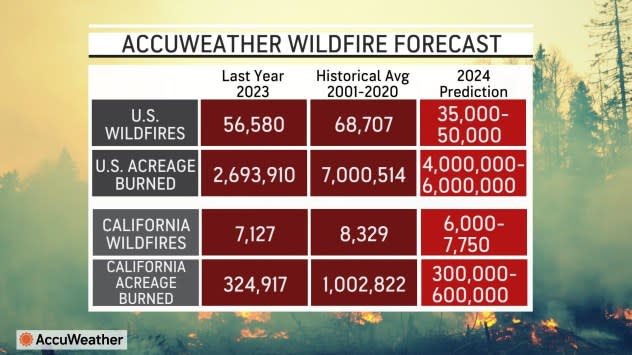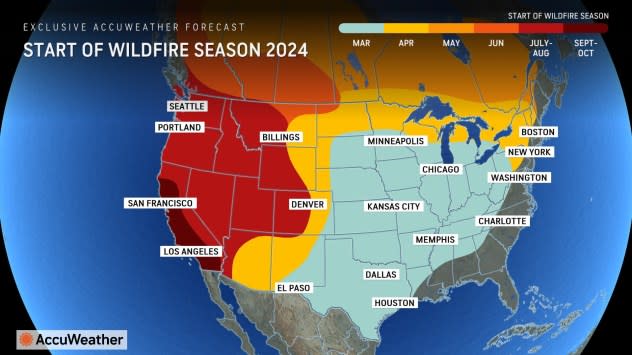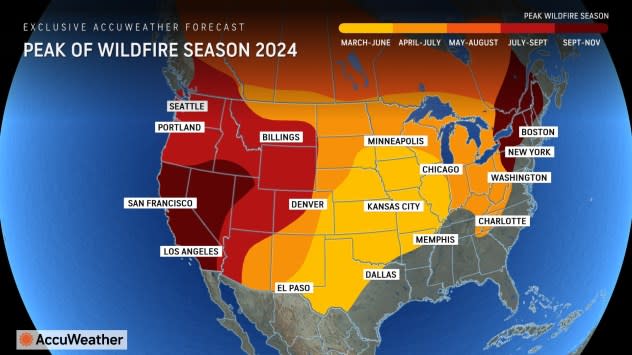Bad air quality, smoky sky at forefront of 2024 wildfire forecast
Wildfires in North America made international headlines in 2023 as millions of people were cast under thick clouds of smoke from massive infernos. Air quality plummeted to dangerous levels and transformed famous skylines into views more akin to an apocalyptic horror movie.
The 2024 wildfire season is right around the corner, and although AccuWeather meteorologists are not expecting a record-shattering season, it may still bring air quality risks similar to what was experienced last year across the continent.
Last year, wildfires in the United States burned 2,693,910 acres of land, significantly lower than the historical average of around 7 million acres. It was also the fewest acres burned since 1998, when around 1.3 million acres were scorched, according to the National Interagency Fire Center.
A much different story unfolded across Canada, which experienced an unprecedented wildfire season with fallout that reached areas thousands of miles away. More than 45.7 million acres of land were scorched amid historic blazes, nearly three times higher than the previous record of 17.5 million acres burned in Canada in 1995.
Massive clouds of smoke shrouded parts of Ontario, Quebec, the Midwest and the Northeast unlike anything seen in recent history.
 |
A man pauses to look at the smoke and haze shrouding One World Trade Center building in New York City, Wednesday, June 7, 2023. Intense Canadian wildfires are blanketing the northeastern U.S. in a haze, turning the air acrid and the sky yellowish gray. (AP Photo/J. David Ake) |
In the United States, the worst fire of 2023 occurred in Lahaina, Hawaii, located on the island of Maui. The firestorm was the deadliest blaze in the U.S. in over a century, killing 101 people.
The 2024 U.S. wildfire season is expected to be below the historical average in terms of the number of fires and acres burned, AccuWeather's Wildfire Team said. Fires across the country are predicted to burn between 4 and 6 million acres of land in 2024, below the historical average of around 7 million acres.
 |
Similar to last year, fire activity is projected to be higher across Canada.
The Canadian wildfire season is expected to be near to above average overall in terms of the number of fires and well above average in terms of the acreage burned. However, the numbers will be much less than those of the record-shattering season of 2023.
There are concerns that air quality could be impacted periodically due to larger blazes that may break out.
Air quality across Canada and the northern U.S. could worsen at times during the summer, affecting people outside, especially those with breathing conditions, AccuWeather Meteorologist Brandon Buckingham said.
People can find a detailed air quality forecast for their area by visiting AccuWeather's Air Quality Center, powered by Plume Labs.
The western half of the U.S. typically accounts for some of the largest wildfires across the country. This year, it may take some time for the wildfire season to ramp up across the West Coast states and Rocky Mountains.
Stormy weather lingering over the Northwest into the latter part of spring will put a lid on both wildfires and measures humans take to suppress the fire danger. "Prescribed burns may be put on hold in the Northwest during May and early June due to above-average precipitation," Buckingham said.
Conditions will gradually become more conducive for fires by midsummer in the Northwest and northern Rockies. Wildfire season in these regions will begin to kick into gear in July and persist into early autumn.
 |
The annual monsoon across the southwestern U.S. is one of the key factors in fire activity across the region.
Monsoon-induced thunderstorms can be a double-edged sword. Downpours and an uptick in humidity can help crews battle and contain wildfires while lightning strikes can trigger new infernos. The start of the monsoon in 2024 is likely to be slow at first before picking up in July and August.
Any fires that do break out early in the summer might burn longer due to this delayed start to the monsoon. High heat, dry conditions and high evaporation rates are expected in June and July for the interior Southwest, which can raise the fire risk significantly.
 |
The Oak Fire burns near the Jerseydale community of Mariposa County, Calif., on Saturday, July 23, 2022. (AP Photo/Noah Berger) |
California has been home to some of the worst fires in the U.S. over the past decade, but following a wet and stormy winter, wildfires will likely be limited until later in the summer. Peak fire season in California is expected from September into November.
 |
However, people in California should remain vigilant, as there is still a chance of fires breaking out earlier in the year.
"If extended streaks of heat and dryness occur in May and June, the risk of wildfires can start earlier during the summer, increasing rapidly into the fall for more significant fires," AccuWeather Long-Range Forecaster Paul Pastelok warned. "The combination of 2023 and 2024 wet seasons will contribute to extensive growth of new fuels."
The largest fire so far this year was in Texas, where a rapidly spreading grassfire fueled by powerful winds scorched more than 1 million acres, left at least two people dead and killed at least 7,000 head of cattle.
AccuWeather meteorologists say this region of the Texas Panhandle and other nearby areas of the southern Plains face a high to extreme risk of significant fires in 2024.
 |
Significant fires could also break out around Michigan, Wisconsin, Minnesota and northwestern Ontario, due in part to weather patterns across the region dating back to late last year.
"The risk of wildfires could increase quickly across the Upper Midwest in the second half of spring because of the record-breaking warmth and dryness across the region this past winter," Pastelok explained. Some precipitation in the Midwest and Great Lakes could briefly reduce the fire threat during the spring months, but as summer arrives, the risk will rise even higher.
June and July pose a particularly elevated fire risk for these areas due to an uptick in thunderstorm activity. Lightning from storms can potentially spark some fires.
In the Northeast, significant greening will prevent late-spring and early-summer fires, Buckingham said. This is much different from 2023 when New Jersey had its worst wildfire season in 20 years.
"If it becomes drier for a significant amount of time for the middle to late summer in the Northeast, then the risk of fires can elevate heading into the fall," Buckingham added.
GET THE FREE ACCUWEATHER APP
•Have the app? Unlock AccuWeather Alerts™ with Premium+
Smoke from fires may billow across the Midwest and the eastern U.S., once again raising air quality concerns, especially for those with conditions such as asthma or emphysema.
Experts recommend preparing for the upcoming wildfire season now so that when a fire does break out, people at risk know what to do and how to escape safely.
Want next-level safety, ad-free? Unlock advanced, hyperlocal severe weather alerts when you subscribe to Premium+ on the AccuWeather app. AccuWeather Alerts™ are prompted by our expert meteorologists who monitor and analyze dangerous weather risks 24/7 to keep you and your family safer.







